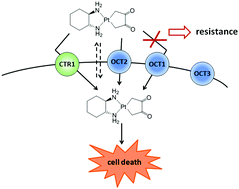当前位置:
X-MOL 学术
›
Metallomics
›
论文详情
Our official English website, www.x-mol.net, welcomes your
feedback! (Note: you will need to create a separate account there.)
Relevance of copper transporter 1 and organic cation transporters 1–3 for oxaliplatin uptake and drug resistance in colorectal cancer cells
Metallomics ( IF 2.9 ) Pub Date : 2018-01-30 00:00:00 , DOI: 10.1039/c7mt00334j I. Buß 1, 2, 3, 4 , A. Hamacher 4, 5, 6, 7 , N. Sarin 1, 2, 3, 4 , M. U. Kassack 4, 5, 6, 7 , G. V. Kalayda 1, 2, 3, 4
Metallomics ( IF 2.9 ) Pub Date : 2018-01-30 00:00:00 , DOI: 10.1039/c7mt00334j I. Buß 1, 2, 3, 4 , A. Hamacher 4, 5, 6, 7 , N. Sarin 1, 2, 3, 4 , M. U. Kassack 4, 5, 6, 7 , G. V. Kalayda 1, 2, 3, 4
Affiliation

|
Oxaliplatin is a routinely used drug in the treatment of colorectal cancer. However, development of resistance is a major hurdle of the chemotherapy success. Defects in cellular accumulation represent a frequently reported feature of cells with acquired resistance to platinum drugs. Nevertheless, the mechanisms of oxaliplatin uptake and their role in oxaliplatin resistance remain poorly elucidated. The aim of this study was to investigate the relevance of copper transporter 1 (CTR1) and organic cation transporters 1–3 (OCT1-3) for oxaliplatin uptake and resistance to the drug in sensitive and oxaliplatin-resistant ileocecal colorectal adenocarcinoma cells. Co-incubation with copper(II) sulfate, a CTR1 substrate, significantly decreased oxaliplatin accumulation but not cytotoxicity in both cell lines. Pre- as well as co-incubation with the OCT1 inhibitor atropine led to a significant reduction in oxaliplatin accumulation in sensitive but not in resistant cells. However, oxaliplatin cytotoxicity was also decreased in the presence of atropine in both cell lines. Cimetidine, an inhibitor of OCT2, induced a significant reduction in the cellular accumulation and potency of oxaliplatin in sensitive and resistant cells. An inhibitor of OCT3, decynium-22, had no influence on oxaliplatin accumulation and cytotoxicity in either cell line. No differences in the transporter expressions were observed between the cell lines, drug-treated or not, either at the mRNA or protein levels. A fluorescent oxaliplatin derivative CFDA-oxPt co-localized with CTR1, OCT1 and OCT2 in sensitive cells, but only with CTR1 and OCT2 in the resistant cell line. Our results suggest that oxaliplatin is transported into the cell by CTR1 in both cell lines. However, contribution of CTR1-mediated uptake to resistance seems unlikely. Uptake of oxaliplatin via OCT1 appears to take place in the sensitive but not in the resistant cell line underscoring the transporter relevance for oxaliplatin resistance. OCT2 is likely to be involved in the uptake of oxaliplatin to a similar extent in both cell lines suggesting no major contribution of this transporter to resistance. In contrast, OCT3 appears to be irrelevant for oxaliplatin transport into the cell and resistance.
中文翻译:

铜转运蛋白1和有机阳离子转运蛋白1-3与结直肠癌细胞摄取草酸铂和耐药性的相关性
奥沙利铂是用于治疗大肠癌的常规药物。然而,耐药性的发展是化学疗法成功的主要障碍。细胞积累缺陷代表了对铂药物具有后天抗性的细胞的经常报道的特征。然而,奥沙利铂摄取的机制及其在奥沙利铂耐药性中的作用仍不清楚。这项研究的目的是研究铜转运蛋白1(CTR1)和有机阳离子转运蛋白1-3(OCT1-3)在敏感和耐草酸铂的回盲肠结直肠腺癌细胞中对草酸铂吸收和耐药性的相关性。与铜共孵育(II硫酸盐,一种CTR1底物,在两种细胞系中均显着降低了奥沙利铂的积累,但没有细胞毒性。与OCT1抑制剂阿托品一起进行预培养和共培养可导致敏感细胞中奥沙利铂积累的显着减少,但耐药细胞中却没有。但是,在两种细胞系中都存在阿托品的情况下,奥沙利铂的细胞毒性也降低了。西咪替丁是OCT2的抑制剂,可诱导敏感和耐药细胞中奥沙利铂的细胞蓄积和效力显着降低。OCT3抑制剂decynium-22对这两种细胞系中的奥沙利铂累积和细胞毒性均无影响。在mRNA或蛋白质水平上,无论是否用药物处理的细胞系之间,均未观察到转运蛋白表达的差异。荧光奥沙利铂衍生物CFDA-oxPt在敏感细胞中与CTR1,OCT1和OCT2共定位,但在耐药细胞系中仅与CTR1和OCT2共定位。我们的结果表明,奥沙利铂在两种细胞系中均由CTR1转运到细胞中。但是,CTR1介导的摄取对耐药性的贡献似乎不大。奥沙利铂的摄取经由OCT1似乎发生在敏感但不是在抗性细胞系强调奥沙利铂抗性的转运蛋白的相关性。在两个细胞系中,OCT2可能以相似的程度参与了奥沙利铂的吸收,表明该转运蛋白对耐药性无重大贡献。相反,OCT3似乎与奥沙利铂转运到细胞和耐药性无关。
更新日期:2018-01-30
中文翻译:

铜转运蛋白1和有机阳离子转运蛋白1-3与结直肠癌细胞摄取草酸铂和耐药性的相关性
奥沙利铂是用于治疗大肠癌的常规药物。然而,耐药性的发展是化学疗法成功的主要障碍。细胞积累缺陷代表了对铂药物具有后天抗性的细胞的经常报道的特征。然而,奥沙利铂摄取的机制及其在奥沙利铂耐药性中的作用仍不清楚。这项研究的目的是研究铜转运蛋白1(CTR1)和有机阳离子转运蛋白1-3(OCT1-3)在敏感和耐草酸铂的回盲肠结直肠腺癌细胞中对草酸铂吸收和耐药性的相关性。与铜共孵育(II硫酸盐,一种CTR1底物,在两种细胞系中均显着降低了奥沙利铂的积累,但没有细胞毒性。与OCT1抑制剂阿托品一起进行预培养和共培养可导致敏感细胞中奥沙利铂积累的显着减少,但耐药细胞中却没有。但是,在两种细胞系中都存在阿托品的情况下,奥沙利铂的细胞毒性也降低了。西咪替丁是OCT2的抑制剂,可诱导敏感和耐药细胞中奥沙利铂的细胞蓄积和效力显着降低。OCT3抑制剂decynium-22对这两种细胞系中的奥沙利铂累积和细胞毒性均无影响。在mRNA或蛋白质水平上,无论是否用药物处理的细胞系之间,均未观察到转运蛋白表达的差异。荧光奥沙利铂衍生物CFDA-oxPt在敏感细胞中与CTR1,OCT1和OCT2共定位,但在耐药细胞系中仅与CTR1和OCT2共定位。我们的结果表明,奥沙利铂在两种细胞系中均由CTR1转运到细胞中。但是,CTR1介导的摄取对耐药性的贡献似乎不大。奥沙利铂的摄取经由OCT1似乎发生在敏感但不是在抗性细胞系强调奥沙利铂抗性的转运蛋白的相关性。在两个细胞系中,OCT2可能以相似的程度参与了奥沙利铂的吸收,表明该转运蛋白对耐药性无重大贡献。相反,OCT3似乎与奥沙利铂转运到细胞和耐药性无关。











































 京公网安备 11010802027423号
京公网安备 11010802027423号